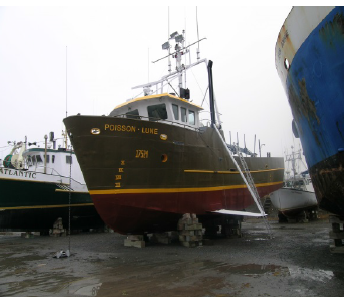For those interested here is a gisted translation of the summary page of the link provided by the OP:
SUMMARY
Comparing the statistics of fatal accidents in the fishing industry and those of other professional categories reveals that fishing is one of the most dangerous occupations. Aboard a ship, the work is done in difficult conditions on a platform moving, exposed to the weather and slippery. For reasons of safety and ease of execution during fishing operations, workers are seeking to reduce the influence of ship motion, using the roll damping systems whose main function is to limit lateral movement without much influence longitudinal movements (pitch) caused by the sea. This project was, firstly, to inventory depreciation systems roll semi-seas fishing vessels operating in Québec and, secondly, to conduct comparative testing of performance of the two most popular systems in Quebec: the hinged ailerons to a rapidly emerging system and those to paravanes, the most widely used system in our fleets.
The inventory revealed that half of the 292 vessels over 15 tons are equipped with a system paravanes, while the hinged flaps system comes a close second (11%) as the roll damping device. The implementation of the latter, however, is growing. In addition, a survey that 53% of 30 joined skipper-owners who had their equip hinged ailerons ship in late October 2010, reveals a high level of satisfaction on all levels: easy handling, comfort, safety and overall performance at sea.
In summer 2010, sea trials were conducted aboard two twin crabbers, Martine Danie equipped paravanes and Rudy L1, equipped with hinged ailerons. The purpose of these tests was to verify whether the L1 Rudy favorably included with respect to three areas of concern fishermen and regulators: the stability of the boat, the safety and comfort of the crew, as well as energy costs (fuel). Three days of sea trials were conducted in the Chaleur Bay off the coast of the Gaspé Peninsula. Each day included 21 trials of 15 minutes each during which three major variables were tested: 1) the position of the damping system (vertical, semi-deployed and immersed); 2) the speed of the boat, based on operational situations (drift, half speed as in a fishing operation and full speed as in the path between the pier and fishing ground); 3) the ship's position according to wind direction (front, back through). Data were recorded continuously using specialized tools such: an inertial unit, a torque indicator deployed on the drive shaft, the speed relative to the background as the GPS position, direction and speed wind by means of an anemometer. Weather conditions experienced during the three days were pretty mild so that the agitation of the sea was rather moderate.
Whereas this environment, the average values of the amplitude of the roll, recorded during lateral movements of Danie Martine and Rudy L1, ranged within a safe range, spread between 2 and 6 degrees. Specifically, the results show that the average minimum values of the amplitude of the roll were recorded on Danie Martine; while the maximum values were observed on Rudy L1, although the differences were small, especially when the roll damping systems were immersed. The amplitude of the pitch values were lower when the boats were drifting or at half speed and the roll damping systems were not deployed. The minimum values were around 1 degree; while the maximum values were in the order of 2.5 degrees. Traveling, Rudy L1 showed a higher pitch than the amplitude Danie Martine. In terms of energy consumption, Rudy L1 was more efficient than Martine Danie at half speed; while the energy required for their movement was equivalent to full speed when the roll damping systems were deployed.
Like the system paravanes, the hinged ailerons system can be considered a beneficial system in terms of reduction of roll, allowing better overall stability of the boat and an improvement in the safety of the crew. Similarly, our visual observations show that hinged ailerons are simpler and easier to deploy by the crew that paravanes. Besides, it is easier for the captain to determine the scope hinged ailerons, fixed geometry system than paravanes whose geometry is influenced by the water resistance effect on the couple Cables- paravanes. This makes it easier to avoid obstacles that float on the surface or sub-surface.
Translation by Google Translate.
https://translate.google.com




